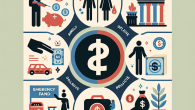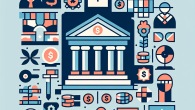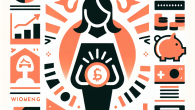
How I Use the 50/30/20 Rule Without Sacrificing Fun or Future
How to Build an Emergency Fund Without Feeling Broke
Let’s be honest—just the term “emergency fund” sounds dull and grown-up. And if you’re anything like me in my early 20s, you’d rather book a weekend getaway than stash away money for a hypothetical disaster. But here’s the reality: life has a way of tossing curveballs, and when it throws a layoff, your car breaks down at the worst moment, or your dog eats something expensive (true story), a well-padded emergency fund becomes your financial superhero.
As your fiercely practical yet optimistic friend in finance, I’m Rachel Simmons—lover of spreadsheets, minimalist living, and guilt-free iced lattes. I’m here to walk you through a smart, sane and surprisingly simple way to build your emergency fund without feeling like your wallet’s on a crash diet.
What Is an Emergency Fund—and Why Should You Care?
An emergency fund is money you set aside in a separate, easily accessible savings account to cover unexpected and urgent expenses. Think: car repairs, sudden medical bills, apartment fixes, or getting let go from your job. This isn’t about funding a last-minute concert ticket or scoring that handbag on sale—that’s splurge territory. We’re talking real, surprise-you-in-a-bad-way kind of emergencies.
Why it matters: Because relying on credit cards or personal loans every time life throws a hiccup at you will keep you trapped in a cycle of debt—and I know you want financial freedom, not more bills.
How Much Should You Save?
Quick rule of thumb: Aim for 3 to 6 months’ worth of essential living expenses.
If that number makes you want to scream into a pillow, breathe. You don’t have to save it all at once. Start where you are. $500 is an amazing initial goal. It can tide you over in minor emergencies and build the habit of saving.
Step 1: Define What “Emergency” Means to You
You need to be crystal clear on what this fund is for so you won’t be tempted to “borrow” from it when that Sephora sale hits.
- Real emergencies: medical bills, job loss, sudden travel due to family illness, essential home or car repairs.
- Not emergencies: birthday gifts, discount flights to Cabo, or a new iPhone.
Write down what qualifies as an emergency in your world and keep it near your savings tracker—it’ll help future-you make better decisions.
Step 2: Set a Target Goal and Timeline
Let’s say your monthly bare-bones expenses (rent, utilities, food, gas) are $2,000. Your 3-month cushion would be $6,000. That’s your long-term emergency fund target.
But we’re going to break that down into manageable milestones:
- Mini emergency fund: $500
- Starter fund: $1,000
- Two-month buffer: $4,000
- Full emergency fund: $6,000+
Pro tip: Set a deadline for each level, but give yourself some breathing room. Progress matters more than perfection.
Step 3: Open a High-Yield Savings Account
This is crucial. You don’t want this money sitting in your checking account where it’s too easy to spend. Nor should it be in your regular savings account earning a pathetic 0.01% APY.
Instead, open a high-yield online savings account. Look for one with no monthly fees, easy access (just not too easy), and a competitive interest rate (as of now, 4%+ is fairly common).
Step 4: Automate It Like a Pro
Emergency funds are like plants—they grow best when you water them regularly. The easiest way to do that without stressing over it every month? Automate your savings.
Set up a recurring transfer for even $25–$50 a week. You probably won’t notice it missing, but you will notice the peace of mind it brings after a few months.
Rachel’s tip: Treat your emergency fund like a bill you owe yourself. Pay it just like you’d pay your landlord or your cell provider—only this time, you’re the one who benefits.
Step 5: Make Room in Your Budget—Without Living Like a Hermit
I’m not about to tell you to stop living. But consider trimming some fat from areas that matter less to you. For example:
- Pause 2–3 subscriptions you barely use
- Choose 2 no-spend days per week
- Bring lunch from home 3x a week instead of 5
- Streamline grocery spending by planning meals
A few tweaks can easily free up $100–$300 a month. That’s serious emergency fund ammo. And hey, you’re still enjoying life, just with smarter spending.
Step 6: Funnel Extra Cash Into Your Fund
Got a tax refund, work bonus, side hustle money, or grandma sent you a birthday check? That’s opportunity knocking.
Put a good chunk (not all) of windfalls into your emergency savings. Even a one-time $200 deposit can speed up your timeline significantly.
Side note from your financially fierce cheerleader: Always leave room for fun money—it’s how we avoid burnout. Give yourself a reward too!
Step 7: Keep It Separate. No Touching. Seriously.
Keep your emergency fund out of reach from your everyday spending or mental budgeting.
That means:
- No debit card attached
- No app notifications luring you to withdraw
- Resist the urge to ‘borrow’ from it—even if you promise to pay it back next payday
Trust me, future-you will thank you when life smacks you sideways and you don’t have to panic-swipe your way into more debt.
You Got This: Build Slowly, but Consistently
To recap: building an emergency fund isn’t about deprivation—it’s about empowerment. It’s how you protect your progress, preserve your independence, and avoid being one bad week away from financial chaos.
You don’t have to be rich to build this safety net. You just need patience, a plan, and the confidence that your future is worth investing in—even when no crisis is in sight.
Need Help Staying on Track?
Print a savings tracker. Find an accountability partner. Or just hang out with me more—we talk finance and freedom with a side of sass and spreadsheets around here. If you want to get in touch or ask questions, my door is wide open.
Now—it’s your move. Start simple. Start today. Even $25 is a start, and your emergency fund journey just became non-scary. Let’s build it—without going broke in the process.









Leave a Reply